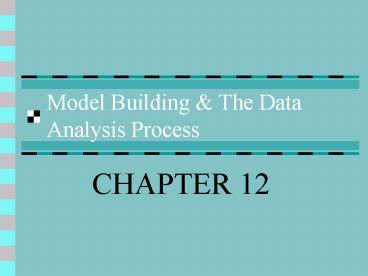Model Building - PowerPoint PPT Presentation
1 / 18
Title:
Model Building
Description:
See Safeway example exhibit 12.2. Page 356. Other Integrated Mining Tools. SAS enterprise miner (http://www.sas.com. IBM intelligent miner(http://www.software.ibm.com. ... – PowerPoint PPT presentation
Number of Views:25
Avg rating:3.0/5.0
Title: Model Building
1
Model Building The Data Analysis Process
- CHAPTER 12
2
Model as means of information
- Modeling is an organizing process for the
business researcher and decision maker. - Model must be able to transform data into
information for it to be considered useful for
decision-making.
3
- Modeling is an interactive process that is
usually a combination of theory and newly
discovered information. - Modeling tools can be easily divided into two
groups - Discovery and hypothesis.
4
Modeling and Data Management
- Data warehousing.
- The turning of gathered data into useful
decision-making information. - Data bases encoded and organized by subject.
- Data warehousing software is capable of
extracting long stored information.
5
Modeling and Data Management
- Data mining.
- Is a knowledge discovery process that extracts
previously unknown information from very large
data bases. - It is a tool that include analytical techniques
such as descriptive statistics, graphical plots,
correlation, linear regression, discriminant
analysis, factor analysis, and data visualization
techniques. - See Safeway example exhibit 12.2. Page 356.
6
Other Integrated Mining Tools
- SAS enterprise miner (http//www.sas.com.
- IBM intelligent miner(http//www.software.ibm.com.
- It enables users to recognize and classify
correlation in their warehoused data by
automatically performing such analyses as cluster
analysis, predictive modeling, database
segmentation, and classification that will help a
company improve its ability to react to markets.
7
Types of Models
- The two basic types of decision models that can
be used to transform a complex real-world process
into a more manageable representation of that
process are - The verbal model and the mathematical model
8
Types of Models
- The verbal model.
- It is more easily understood by decision makers.
- It can be readily applied to virtually any
decision problem. - However, it could be quite difficult to implement
because of the possibility of omitting many
implied variables and relationships that could
affect the objective of the decision maker.
9
Types of Models
- Mathematical model.
- It can describe complex relationships in a
precise and concise manner. - It can be directly used to manipulate variables
to arrive at outcomes. - Mathematics can easily be programmed for computer
solution. - Mathematical model is deterministic in the sense
that it is assumed that decision variables are
known, and uncontrollable variables are excluded
from consideration because their values are not
known with certainty.
10
Stochastic Probabilistic Model
- STOCHASTIC model is when the decision variables
are represented by random processes. - PROBABILISTIC model is when uncontrollable
variables represented by random processes are
incorporated into the model via one or more
possible forms of probability assignment.
11
Model Classification
- The three common elements of classification are
- Level of aggregation/aggregation.
- Micro model of individual or situational
behavior of a particular company. - Macro companies behavior in the environment.
12
Model Classification
- Aggregation.
- Disaggregate model individuals choice.
- Aggregate model choice for all individuals.
13
Model Classification
- Time dimension.
- Dynamic changes in process due to changes in
the variable specification over time, like a
moving phenomenon. More costly than static. - Static variables measured at a specific point
in time i.E a single snapshot.
14
Model Classification
- Degree of uncertainty.
- Deterministic all decision variable values are
known within a discrete range i.E they operate
under conditions of uncertainty. This models do
not rely on the laws of probability for
estimating variable values. - Researcher is willing to assume that demand is
known. - It include linear programming, break-even
analysis, linear curves, critical path network
analysis and time series analysis.
15
- Stochastic or probabilistic the values of one
or more decision and/or uncontrollable variables
are not known with certainty, so some form of
choice process must be used to estimate the
values of those variables to be used. - It is more expensive to use this model because of
their greater computational requirements and more
complex solution techniques.
16
- This model include decision theory, queuing
theory, program evaluation review technique
network analysis (PERT), Monte Carlo simulation,
and Markov processes. - In this situation the choice process used for
this purpose assumes that variable values occur
randomly, and a relevant probability distribution
can be ascertained for each variable.
17
Model Specification Managerial Objectives of
Modeling
- Regression ANOVA.
- The four basic objectives of using models to
solve particular decision problem are - Classification a.Ka. Taxonomic models used to
categorize events, entities to aid decision
making(see appendix A, p.549).
18
Model Specification Managerial Objectives of
Modeling
- Description and explanation or empirical if it
contains data for parameter estimation. - Prediction applied at a more operational level
as a decision making aid for predicting future
events. - Optimization or normative modeling.
- It provide suggestions as to the best course of
action.































